Isostatic Adjustment, Vertical Motion Rate Variation and Potential Detection of Past Abrupt Mass Unloading
Abstract
:1. Introduction
2. Geological and Geomorphological Setting
3. Materials and Methods
4. Results
5. Discussion
5.1. Effect of a Giant Landslide on Vertical Motion
5.2. Effect of a Moderate Abrupt Mass Unloading on Vertical Motion
5.3. Sea-Level Variation and Water Loading Hypothesis
5.4. Erosion and Isostatic Response
5.5. Volcano Loading and Vertical Motion
5.6. Triggering Mechanism of Paleo-Landslides
6. Conclusions
Funding
Data Availability Statement
Acknowledgments
Conflicts of Interest
References
- Blahüt, J.; Balek, J.; Klimeš, J.; Rowberry, M.; Kusák, M.; Kalina, J. A comprehensive global database of giant landslides on volcanic islands. Landslides 2019, 16, 2045–2052. [Google Scholar] [CrossRef]
- Clouard, V.; Bonneville, A. Submarine Landslides in French Polynesia. In Oceanic Hotspots; Hekinian, R., Cheminée, J.L., Stoffers, P., Eds.; Springer: Berlin, Germany, 2004; pp. 209–238. [Google Scholar] [CrossRef]
- Moore, J.G.; Bryan, W.B.; Beeson, M.H.; Normark, W.R. Giant blocks in the South Kona landslide, Hawaii. Geology 1995, 23, 125–128. [Google Scholar] [CrossRef]
- Cervelli, P.; Segall, P.; Johnson, K.; Lisowski, M.; Miklius, A. Sudden aseismic fault slip on the south flank of Kilauea volcano. Nature 2002, 415, 1014–1018. [Google Scholar] [CrossRef] [PubMed]
- Le Corvec, N.; Walter, T.R. Volcano spreading and fault interaction influenced by rift zone intrusions: Insights from analogue experiments analyzed with digital image correlation technique. J. Volcanol. Geotherm. Res. 2009, 183, 170–182. [Google Scholar] [CrossRef]
- Quidelleur, X.; Hildenbrand, A.; Samper, A. Causal link between Quaternary paleoclimatic changes and volcanic islands evolution. Geophys. Res. Lett. 2008, 35, L02303. [Google Scholar] [CrossRef]
- Carracedo, J.C.; Day, S.J.; Guillou, H.; Pérez Torrado, F.J. Large Quaternary landslides in the evolution of La Palma and El Hierro, Canary Islands. J. Volcanol. Geotherm. Res. 1999, 94, 169–190. [Google Scholar] [CrossRef]
- Crozier, M.J. Deciphering the effect of climate change on landsliding activity: A review. Geomorphology 2010, 124, 260–267. [Google Scholar] [CrossRef]
- Gargani, J.; Bache, F.; Jouannic, G.; Gorini, C. Slope destabilization during the Messinian Salinity Crisis. Geomorphology 2014, 213, 128–138. [Google Scholar] [CrossRef]
- Hampel, A.; Hetzel, R. Slip reversals on active normal faults related to the inflation and deflation of magma chambers: Numerical modelling with application to the Yellowstone-Teton region. Geophys. Res. Lett. 2008, 35, L07301. [Google Scholar] [CrossRef]
- Kilburn, C.R.J.; Petley, D.N. Forecasting giant, catastrophic slope collapse: Lessons from Vajont, Northern Italy. Geomorphology 2003, 54, 21–32. [Google Scholar] [CrossRef]
- McMurtry, G.M.; Watts, P.; Fryer, G.J.; Smith, J.R.; Imamura, F. Giant landslides, mega-tsunamis, and paleo-sea level in the Hawaiian Islands. Mar. Geol. 2004, 203, 219–233. [Google Scholar] [CrossRef]
- Veveakis, E.; Vardoulakis, I.; Di Toro, G. Thermoporomechanics of creeping landslides: The 1963 Vaiont slide, northern Italy. J. Geophys. Res. 2007, 112, F03026. [Google Scholar] [CrossRef]
- Brunetti, M.T.; Guzzetti, F.; Rossi, M. Probability distributions of landslide volumes. Nonlinear Process. Geophys. 2009, 16, 179–188. [Google Scholar] [CrossRef]
- Staron, L.; Lajeunesse, E. Understanding how volume affects the mobility of dry debris flows. Geophys. Res. Lett. 2009, 36, L12402. [Google Scholar] [CrossRef]
- De Blasio, F.V. Frontal Aureole Deposit on Acheron Fossae ridge as evidence for landslide-generated tsunami on Mars. Planet. Space Sci. 2020, 187, 104911. [Google Scholar] [CrossRef]
- Smith, J.R.; Wessel, P. Isostatic consequences of giant landslides on the Hawaiian ridge. Pure Appl. Geophys. 2000, 157, 1097–1114. [Google Scholar] [CrossRef]
- Keating, B.H.; Helsley, C.H. The ancient shorelines of Lanai, Hawaii, revisited. Sediment. Geol. 2002, 150, 3–15. [Google Scholar] [CrossRef]
- Menendez, I.; Silva, P.G.; Martin-Betancor, M.; Pérez-Torrado, F.J.; Guillou, H.; Scaillet, S. Fluvial dissection, isostatic uplift, and geomorphological evolution of volcanic islands (Gran Canaria, Canary Islands, Spain). Geomorphology 2008, 102, 189–203. [Google Scholar] [CrossRef]
- Clouard, V.; Bonneville, A.; Gillot, P.-Y. A large landslide on the southern flank of Tahiti Island, French Polynesia. Geophys. Res. Lett. 2001, 28, 2253–2256. [Google Scholar] [CrossRef]
- Hildenbrand, A.; Gillot, P.-Y.; Bonneville, A. Offshore evidence for a huge landslide of the northern flank of Tahiti-Nui (French Polynesia). Geochem. Geophys. Geosyst. 2006, 7, Q03006. [Google Scholar] [CrossRef]
- Ramalho, R.S.; Quartau, R.; Trenhaile, A.S.; Mitchell, N.C.; Woodroffe, C.D.; Avila, S.P. Coastal evolution on volcanic oceanic islands: A complex interplay between volcanism, erosion, sedimentation sea-level and biogenic production. Earth-Sci. Rev. 2013, 127, 140–170. [Google Scholar] [CrossRef]
- Lambeck, K. Volcanic Loading and Isostasy. In Encyclopedia of Modern Coral Reefs; Encyclopedia of Earth Sciences, Series; Hopley, D., Ed.; Springer: Dordrecht, The Neitherland, 2011. [Google Scholar] [CrossRef]
- Pirazzoli, P.A.; Montaggioni, L.F. The 7000 yr sea-level curve in French Polynesia: Geodynamic implications for mid-plate volcanic islands. In Proceedings of the 6th International Coral Reef Symposium, Townsville, Australia, 8–12 August 1988; Volume 3, pp. 467–472. [Google Scholar]
- Bard, E.; Hamelin, B.; Arnold, M.; Montaggioni, L.; Cabiosh, G.; Faure, G.; Rougerie, F. Deglacial sea-level record from Tahiti corals and the timing of global meltwater discharge. Nature 1996, 382, 241–244. [Google Scholar] [CrossRef]
- Bard, E.; Hamelin, B.; Delanghe-Sabatier, D. Deglacial Meltwater Pulse 1B and Younger Dryas Sea Levels Revisited with Boreholes at Tahiti. Science 2010, 327, 1235–1237. [Google Scholar] [CrossRef]
- Hallmann, N.; Camoin, G.; Eisenhauer, A.; Botella, G.A.; Milne, C.; Vella, E.; Samankassou, V.; Pothin, P.; Dussouillez, J.; Fleury, J.; et al. Ice volume and climate changes from a 6000 year sea-level record in French Polynesia. Nat. Commun. 2018, 9, 285. [Google Scholar] [CrossRef]
- Miller, K.G.; Kominz, M.A.; Browning, J.V.; Wright, J.D.; Mountain, G.S.; Katz, M.E.; Cramer, B.S.; Cristie-Blick, N.; Pekar, S. The Phanerozoic record of global sea-level change. Science 2005, 310, 1293–1298. [Google Scholar] [CrossRef]
- Milne, G.A.; Gehrels, W.R.; Hughes, C.W.; Tamisiea, M.E. Identifying the causes of sea-level change. Nat. Geosci. 2009, 2, 471–478. [Google Scholar] [CrossRef]
- Laskar, J.; Robutel, P.; Joutel, F.; Gastineau, M.; Correia, A.C.M.; Levrard, B. A long-term numerical solution for the insolation quantities of the Earth. Astron. Astrophys. 2004, 428, 261–285. [Google Scholar] [CrossRef]
- Sahagian, D.L.; Schwartz, F.W.; Jacobs, D.K. Direct anthropogenic contributions to sea level rise in the twentieth century. Nature 1994, 367, 54–57. [Google Scholar] [CrossRef]
- Bard, E.; Hamelin, B.; Deschamps, P.; Camoin, G. Comment on « Younger Dryas Sea level and meltwater pulse 1B recorded in Barbados reefal crest coral Acropora palmata » by N.A. Abdul et al. Paleoceanography 2016, 31, 1603–1608. [Google Scholar] [CrossRef]
- Abdul, N.A.; Mortlock, R.A.; Wright, J.D.; Fairbank, R.G. Younger Dryas sea level and meltwater pulse 1B recorded in Barbasdos reef crest coral Acropora palmate. Paleoceanogr. Paleoclimatol. 2016, 31, 330–344. [Google Scholar] [CrossRef]
- Gargani, J. Relative sea level and abrupt mass unloading in Barbados during the Holocene. Geomorphology 2022, 413, 108353. [Google Scholar] [CrossRef]
- Gargani, J.; Rigollet, C. Mediterranean Sea level variations during the Messinian Salinity Crisis. Geophys. Res. Lett. 2007, 34, L10405. [Google Scholar] [CrossRef]
- Gargani, J.; Moretti, I.; Letouzey, J. Evaporite accumulation during the Messinian Salinity Crisis: The Suez Rift Case. Geophys. Res. Lett. 2008, 35, L02401. [Google Scholar] [CrossRef]
- Thomas, A.L.; Fujita, K.; Iryu, Y.; Bard, E.; Cabioch, G.; Camoin, G.; Cole, J.E.; Deschamps, P.; Durand, N.; Hamelin, B.; et al. Assessing subsidence rates and paleo water-depths for Tahiti reefs using U-Th chronology of altered corals. Mar. Geol. 2012, 295–298, 86–94. [Google Scholar] [CrossRef]
- Fadil, A.; Sichoix, L.; Barriot, J.-P.; Ortega, P.; Willis, P. Evidence for a slow subsidence of the Tahiti Island from GPS, DORIS, and combined satellite altimetry and tide gauge sea level records, C.R. Geoscience 2011, 1856, 323–378. [Google Scholar] [CrossRef]
- Clouard, V.; Bonneville, A. Ages of seamounts, islands, and plateaus on the Pacific plate. In Plates, Plumes and Paradigms; Geological Society of America Special Papers; Geological Society of America: Boulder, CO, USA, 2005; p. 338. [Google Scholar] [CrossRef]
- Le Roy, I. Evolution des volcans en systeme de point chaud: Ile de Tahiti, Archipel de la Societe (Polynesie Francaise). Ph.D. Thesis, University Paris 11, Orsay, France, 1994; 276p. [Google Scholar]
- Duncan, R.A.; McDougall, I. Linear volcanism in French Polynesia. J. Volcanol. Geotherm. Res. 1976, 1, 197–227. [Google Scholar] [CrossRef]
- Munschy, M.; Antoine, C.; Guille, G.; Guillou, H. La croûte océanique et les points chauds de la Polynésie Française (Océan Pacifique central). Géol. Fr. 1998, 3, 5–13. [Google Scholar]
- Patriat, M.; Klingelhoefer, F.; Aslanian, D.; Contrucci, I.; Gutscher, M.-A.; Talandier, J.; Avedik, F.; Francheteau, J.; Weigel, W. Deep crustal structure of the Tuamotu plateau and Tahiti (French Polynesia) based on seismic refraction data. Geophys. Res. Lett. 2002, 29, 1. [Google Scholar] [CrossRef]
- Grevemeyer, I.; Weigel, W.; Schüssler, S.; Avedik, F. Crustal and upper mantle seismic structure and lithospheric flexure along the society Island hotspot chain. Geophys. J. Int. 2001, 147, 123–140. [Google Scholar] [CrossRef]
- Lambeck, K. Flexure of the ocean lithosphere from island uplift, bathymetry and geoid observations: The Society Islands. Geophys. J. R. Astr. Soc. 1981, 67, 91–114. [Google Scholar] [CrossRef]
- Pirazzoli, P.A.; Montaggioni, L.F.; Delibrias, G.; Faure, G.; Salvat, B. Late Holocene sea-level changes in the Society Islands and in the northwest Tuamotu Atolls. In Proceedings of the Fifth International Coral Reef Congress, Tahiti, France, 27 May–1 June 1985; Gabrie, C., Toffart, J.L., Salvat, B., Eds.; Volume 3, pp. 131–136. [Google Scholar]
- Hildenbrand, A.; Gillot, P.-Y.; Marlin, C. Geomorphological study of long-term erosion on a tropical volcanic ocean island: Tahiti-Nui (French Polynesia). Geomorphology 2008, 93, 460–481. [Google Scholar] [CrossRef]
- Gargani, J. Modelling the mobility and dynamics of a large Tahitian landslide using runout distance. Geomorphol. Geomorphol. 2020, 370, 107354. [Google Scholar] [CrossRef]
- Ye, F.Y.; Barriot, J.P.; Carretier, S. Initiation and recession of the fluvial knickpoints of the Island of Tahiti (French Polynesia). Geomorphology 2013, 186, 162–173. [Google Scholar] [CrossRef]
- Watts, A.B. Isostasy and Flexure of the Lithosphere; Cambridge University Press: New York, NY, USA, 2001. [Google Scholar]
- Gargani, J. Modelling of the erosion in the Rhone valley during the Messinian crisis (France). Quat. Int. 2004, 121, 13–22. [Google Scholar] [CrossRef]
- Gargani, J.; Rigollet, C.; Scarselli, S. Istostatic response and geomorphological evolution of the Nile valley during the Messinian salinity crisis. Bull. Soc. Geol. Fr. 2010, 181, 19–26. [Google Scholar] [CrossRef]
- Weissel, J.K.; Karner, G.D. Flexural uplift of rift flanks due to mechanical unloading of the lithosphere during extension. J. Geophys. Res. 1989, 94, 13919–13950. [Google Scholar] [CrossRef]
- Turcotte, D.L.; Schubert, G. Geodynamics, 2nd ed.; Cambridge University Press: New York, NY, USA, 2001; p. 456. [Google Scholar]
- Clouard, V.; Bonneville, A.; Barsczus, H.G. Size and depth of ancient magma chambers under atolls and islands of French Polynesia using detailed gravity data. J. Geophys. Res. 2000, 105, 8173–8192. [Google Scholar] [CrossRef]
- Calmant, S.; Cazenave, A. Anomalous elastic thickness of the oceanic lithosphere in the south-central Pacific. Nature 1987, 328, 236–238. [Google Scholar] [CrossRef]
- Cazenave, A.; Lago, B.; Dominh, K.; Lambeck, K. On the response of the ocean lithosphere to seamount loads from Geos 3satellite radar altimeter observations. Geophys. J. R. Astr. Soc. 1980, 63, 233–252. [Google Scholar] [CrossRef]
- Goodwillie, A.M.; Watts, A.B. An altimetric and bathymetric study of elastic thickness in the central Pacific Ocean. Earth Planet. Sci. Lett. 1993, 118, 311–326. [Google Scholar] [CrossRef]
- Van der Wal, W.; Wu, P.; Wang, H.; Sideris, M.G. Sea levels and uplift rate from composite rheology in glacial isostatic adjustment modelling. J. Geodyn. 2010, 50, 38–48. [Google Scholar] [CrossRef]
- Mitrovica, J.X.; Forte, A.M.; Simons, M. A reappraisal of postglacial decay times from Richmond Gulf and James Bay, Canada. Geophys. J. Int. 2000, 142, 783–800. [Google Scholar] [CrossRef]
- Loget, N.; Van Den Driessche, J. Wave train model for knickpoint migration. Geomorphology 2009, 106, 376–382. [Google Scholar] [CrossRef]
- Binnie, A.; Tibor, J.D.; Binnie, S.A.; Victor, P.; Gonzalez, G.; Boltena, A. Accelerated late quaternary uplift revealed by 10Be exposure dating of marine terraces, Mejillones Peninsula, northern Chile. Quat. Geochronol. 2016, 36, 12–27. [Google Scholar] [CrossRef]
- Martinod, J.; Regard, V.; Riquelme, R.; Aguilar, G.; Guillaume, B.; Carretier, S.; Cortes, J.; Leanni, L.; Hérail, G. Pleistocene uplift, climate and morphological segmentation ofthe northern Chile coasts (24S–32S): Insights from cosmogenic10Be dating of paleoshorelines. Geomorphology 2016, 274, 78–91. [Google Scholar] [CrossRef]
- Guillande, R.; Gelugne, P.; Bardintzeff, J.-M.; Brousse, R.; Chorowicz, J.; Deffontaines, B.; Parrot, J.-F. Cartographie automatique de zones à aléas de mouvements de terrain sur l’île de Tahiti à partir de données digitale. Bull. Soc. Geol. Fr. 1993, 164, 577–583. [Google Scholar]
- Parkes, A.; Teller, J.T.; Flenlev, J.R. Environmental history of the lake Vaihiria drainage basin, Tahiti French Polynesia. J. Biogeogr. 1992, 19, 431–447. [Google Scholar] [CrossRef]
- Rey, T.; Leone, F.; Candela, T.; Belmadani, A.; Palany, P.; Krien, Y.; Cécé, R.; Gherardi, M.; Péroche, M.; Zahibo, N. Coastal processes and influence on damage to urban structures during hurricane Irma (St-Martin and St-Barthélemy, French West Indies). J. Mar. Sci. Eng. 2019, 7, 215. [Google Scholar] [CrossRef]
- Gargani, J. Eustatisme, érosion et isostasie flexurale: Modélisation numérique appliquée au Rhône messinien. C.R. Geosci. 2004, 336, 901–907. [Google Scholar] [CrossRef]
- Gargani, J.; Stab, O.; Cojan, I.; Brulhet, J. Modelling the long-term fluvial erosion of the river Somme during the last million years. Terra Nova 2006, 18, 118–129. [Google Scholar] [CrossRef]
- Lemoine, A.; Briole, P.; Bertil, D.; Roullé, A.; Foumelis, M.; Thinon, I.; Raucoules, D.; de Michele, M.; Valty, P.; Hoste Colomer, R. The 2018–2019 seismo-volcanic crisis east ofMayotte, Comoros islands: Seismicity and ground deformation markers of an exceptional submarine eruption. Geophys. J. Int. 2020, 223, 22–44. [Google Scholar] [CrossRef]
- Binard, N.; Maury, R.C.; Guille, G.; Talandier, J.; Gillot, P.Y.; Cotton, J. Mehetia Island, South Pacific; geology and petrology of the emerged part of the Society hot spot. J. Volcanol. Geotherm. Res. 1993, 55, 239–260. [Google Scholar] [CrossRef]
- German, C.R.; Resing, J.A.; Xu, G.; Yeo, I.A.; Walker, S.L.; Devey, C.W.; Moffett, J.W.; Cutter, G.A.; Hyvernaud, O.; Reymond, D. Hydrothermal Activity and Seismicity at Teahitia Seamount: Reactivation of the Society Islands Hotspot? Front. Mar. Sci. 2020, 7, 73. [Google Scholar] [CrossRef]
- Sichoix, L. Le Volcanisme de Polynésie Française: Caractérisation Des Points Chauds et du Superbombement à Partir D’une Nouvelle Synthèse Bathymétrique. Ph.D. Thesis, University of French Polynesia, Papeete, Tahiti, 1997; p. 297. [Google Scholar]
- Talandier, J.; Okal, E.A. The volcanoseismic swarms of 1981–1983 in the Tahiti Mehetia area, French Polynesia. J. Geophys. Res. 1984, 89, 11216–11234. [Google Scholar] [CrossRef]
- Muller-Salzburg, L. The Vajont catastrophe—A personnal review. Eng. Geol. 1987, 24, 423–444. [Google Scholar] [CrossRef]
- Gargani, J.; Abdessadok, S.; Tudryn, A.; Chapon Sao, C.; Dambricourt, A.; Gaillard, C.; Moigne, A.-M.; Singh, M.; Bhardwaj, V.; Karir, B. Geology and Geomorphology of Masol paleonto-archeological site, Late Pliocene, Chandigarh, Siwalik Frontal Range, NW India. C. R. Palevol 2016, 15, 379–391. [Google Scholar] [CrossRef]
- Rodriguez-Losada, J.A.; Hernandez-Gutérrez, L.E.; Olalla, C.; Perucho, A.; Serrano, A.; Eff-Darwich, A. Geomechanical parameters of intact rocks and rock masses from the Canary Islands: Implications on their flank stability. J. Volcanol. Geotherm. Res. 2009, 182, 67–75. [Google Scholar] [CrossRef]
- Gargani, J.; Geoffroy, L.; Gac, S.; Cravoisier, S. Fault slip and Coulomb stress variations around a pressured magma reservoir: Consequences on seismicity and magma intrusion. Terra Nova 2006, 18, 403–411. [Google Scholar] [CrossRef]
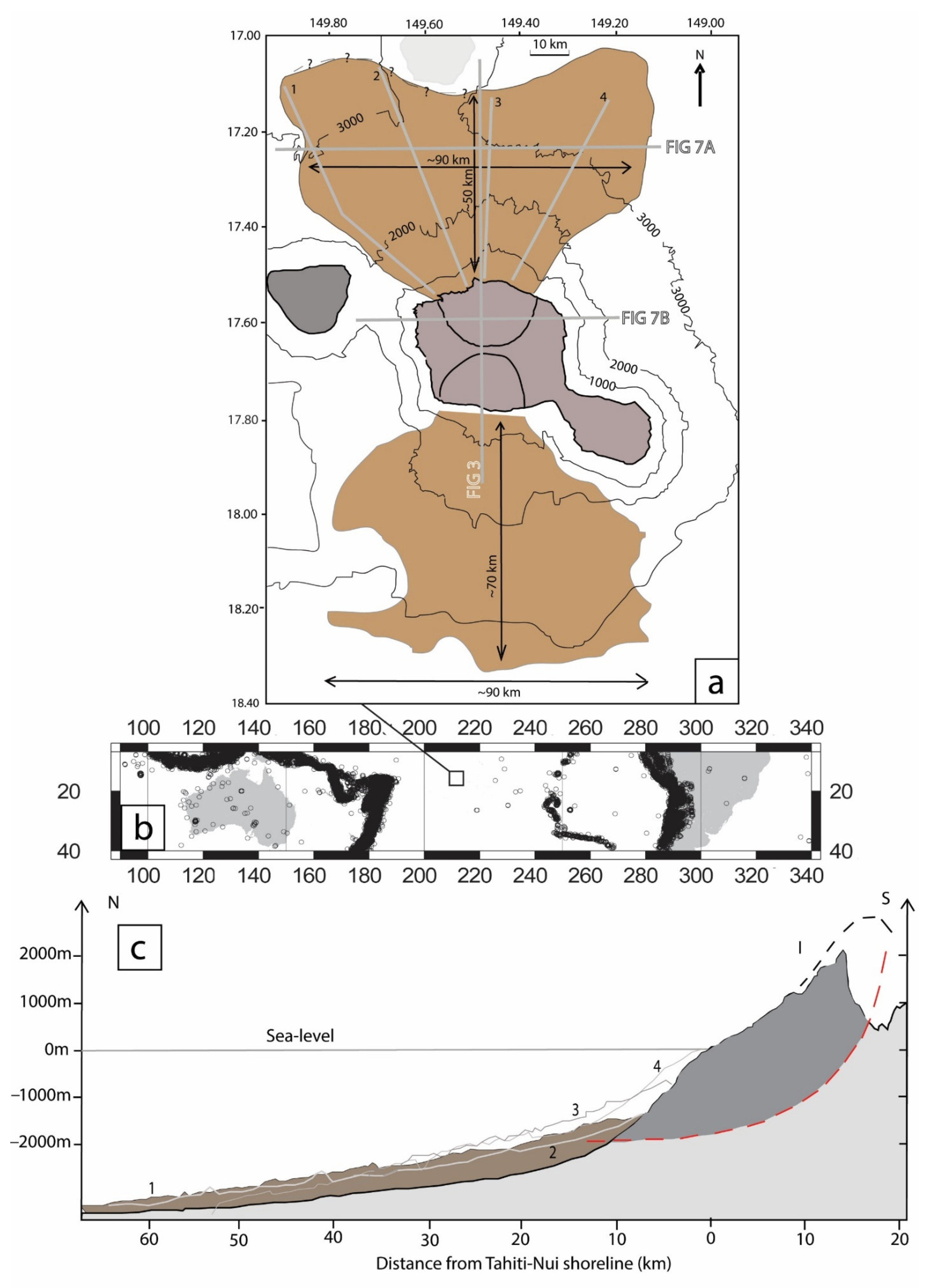

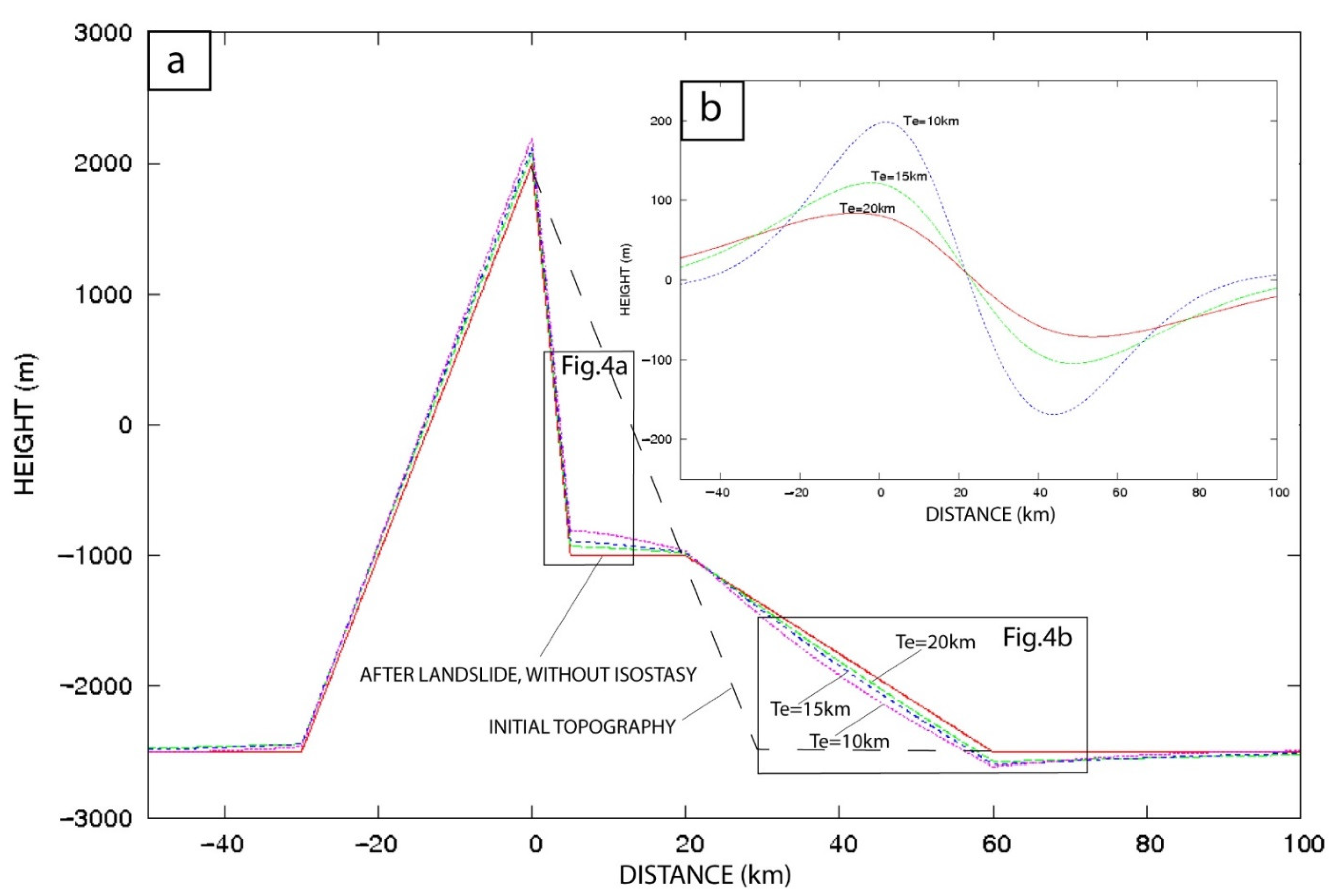
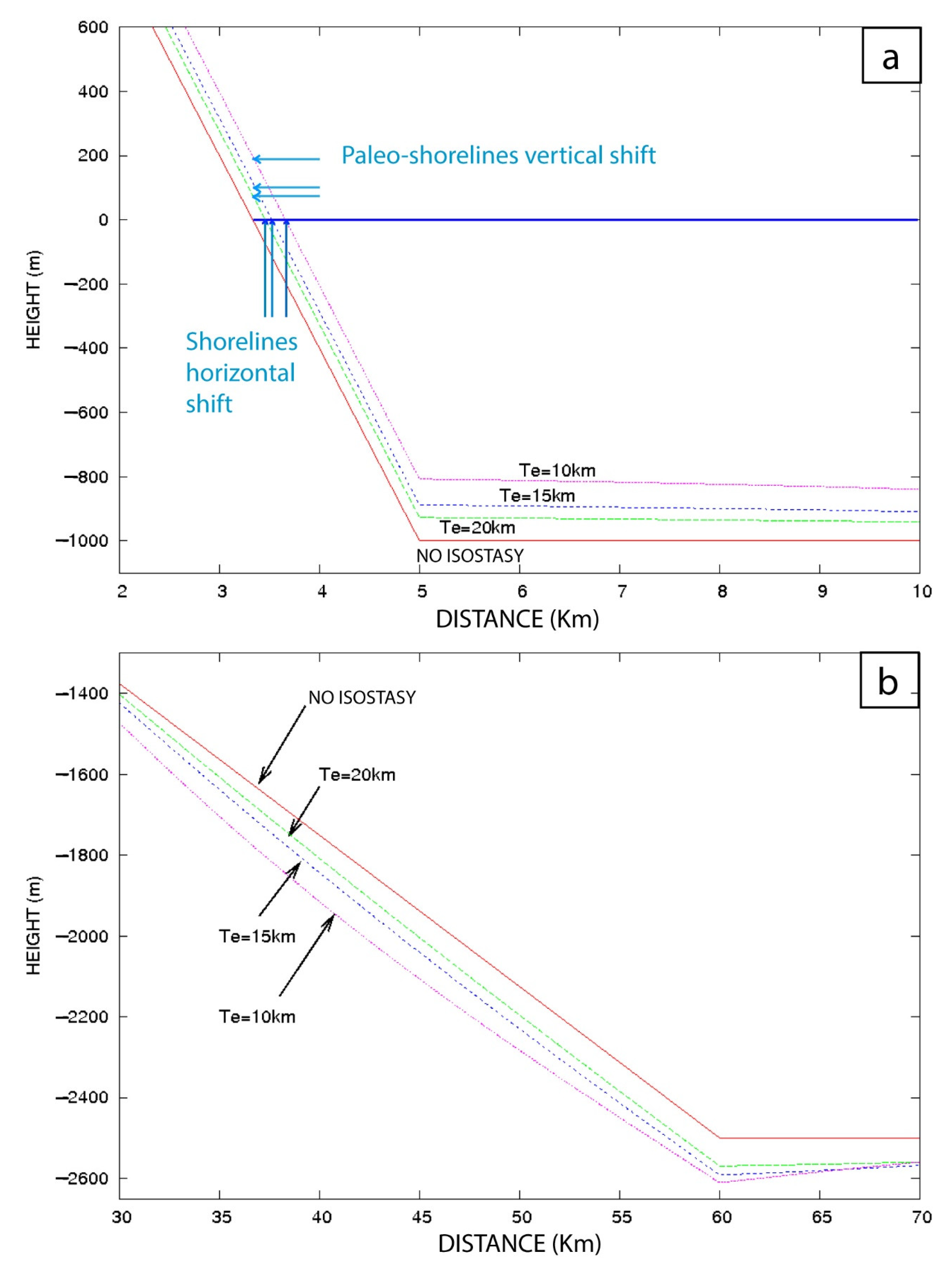

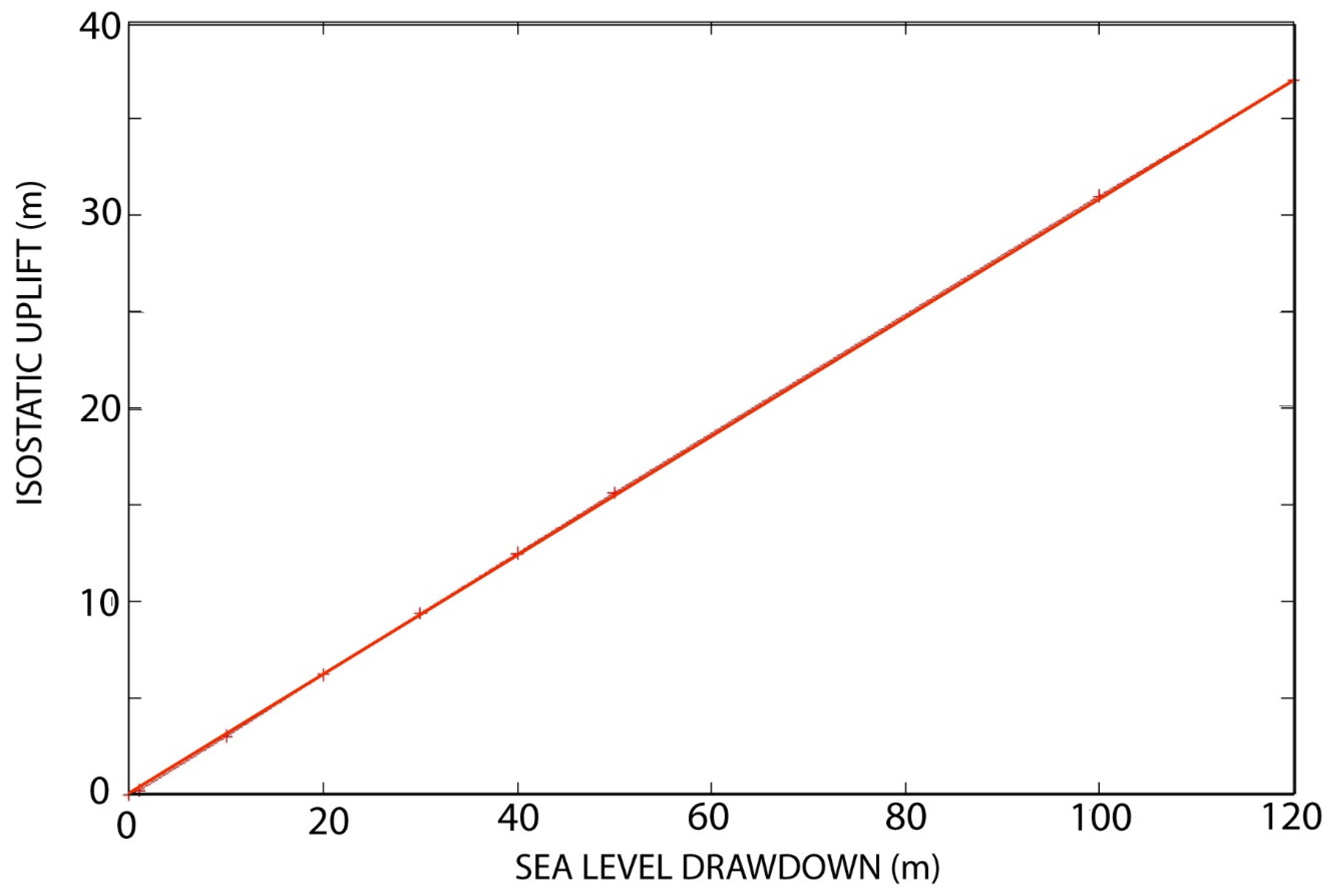
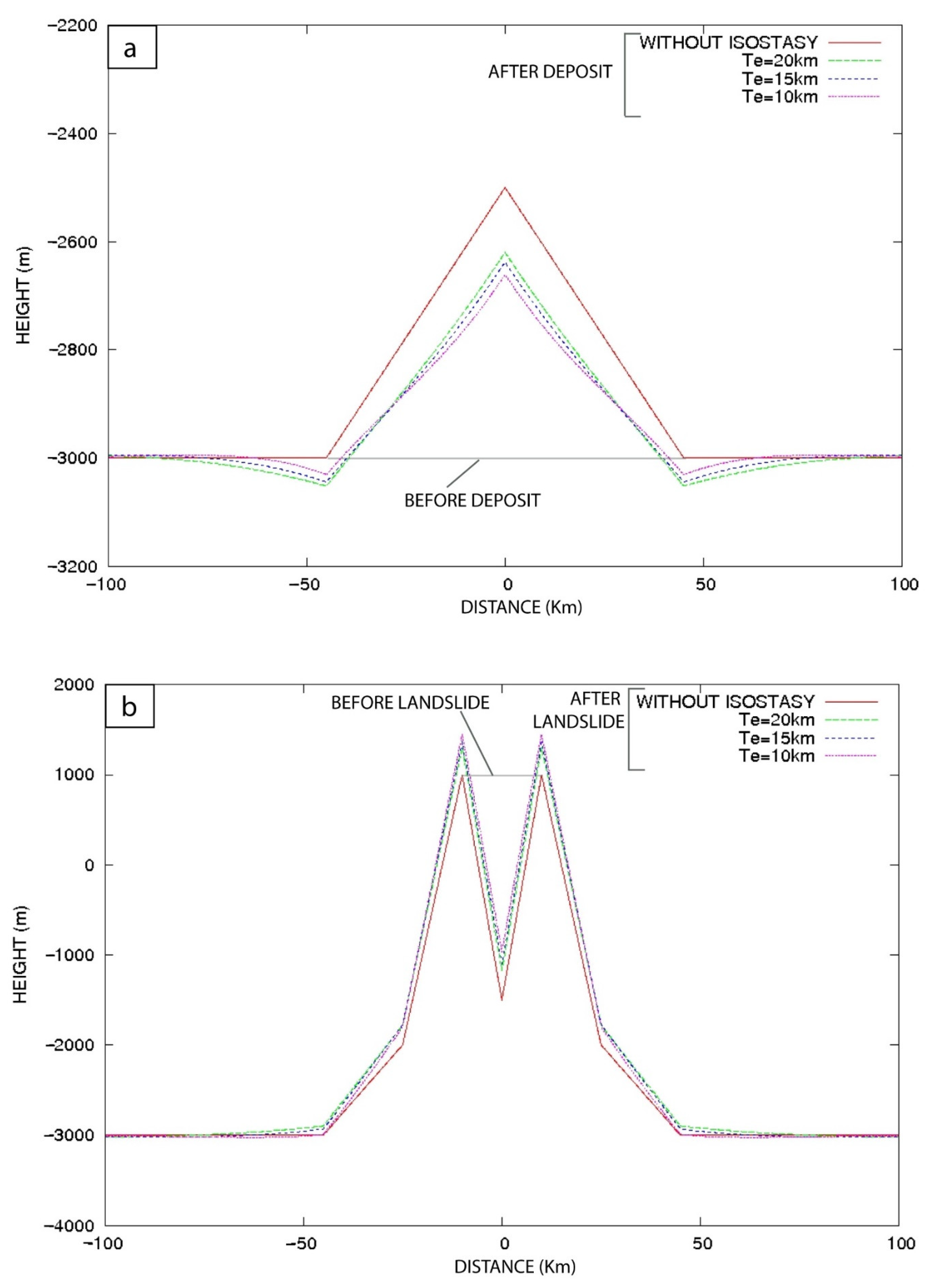
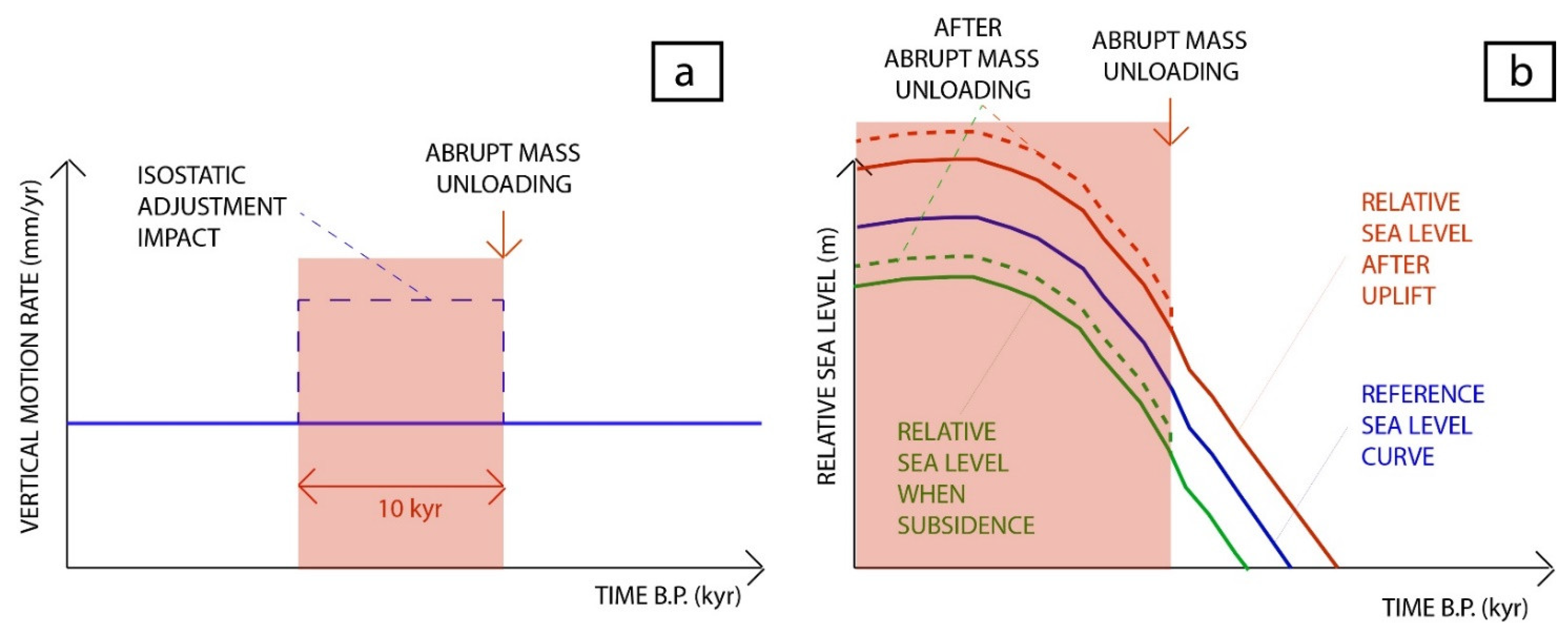
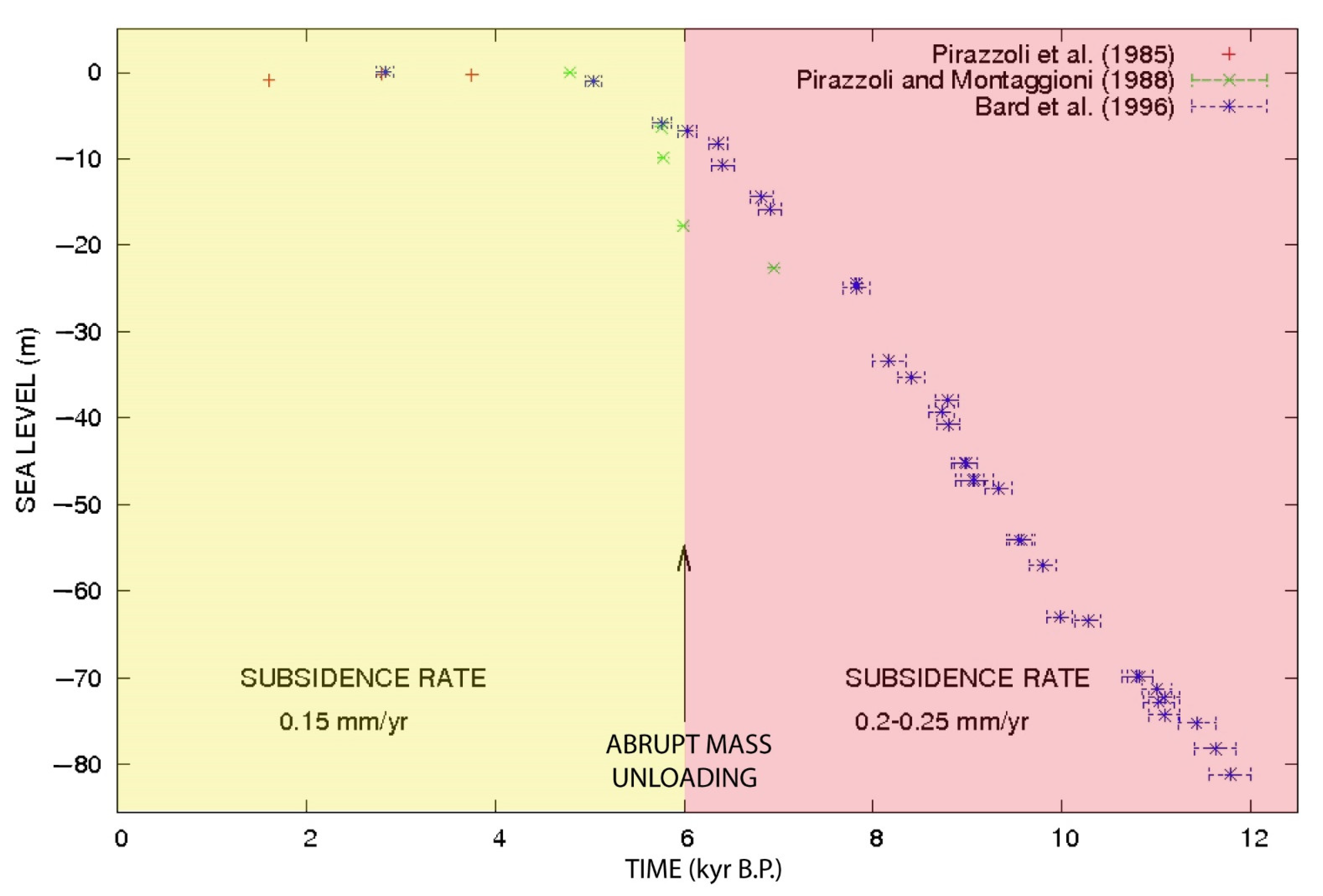
| Abrupt Mass Unloading Section (m2) | Elastic Thickness (Km) |
|---|---|
| 0.2 × 106 | 15 and 20 |
| 0.45 × 106 | 15 and 20 |
| 1 × 106 | 15 and 20 |
| 4 × 106 | 15 and 20 |
| 7 × 106 | 15 and 20 |
| 20 × 106 | 15 and 20 |
| 45 × 106 | 15 and 20 |
| Abrupt Mass Unloading Surface (Section in m2) | Abrupt Mass Unloading Volume (km3) 1 | Abrupt Mass Unloading Width (km) 1 | Elastic Thickness Te (Km) | Coastal Uplift (m) |
|---|---|---|---|---|
| 0.2 × 106 | 0.2 | 1 | 15 | 1.1 |
| 0.2 | 1 | 20 | 0.9 | |
| 10 × 106 | 50 | 5 | 20 | 50 |
| 50 | 5 | 15 | 40 | |
| 50 × 106 | 1000 | 20 | 15 | 160 |
| 1000 | 20 | 20 | 135 |
Publisher’s Note: MDPI stays neutral with regard to jurisdictional claims in published maps and institutional affiliations. |
© 2022 by the author. Licensee MDPI, Basel, Switzerland. This article is an open access article distributed under the terms and conditions of the Creative Commons Attribution (CC BY) license (https://creativecommons.org/licenses/by/4.0/).
Share and Cite
Gargani, J. Isostatic Adjustment, Vertical Motion Rate Variation and Potential Detection of Past Abrupt Mass Unloading. Geosciences 2022, 12, 302. https://doi.org/10.3390/geosciences12080302
Gargani J. Isostatic Adjustment, Vertical Motion Rate Variation and Potential Detection of Past Abrupt Mass Unloading. Geosciences. 2022; 12(8):302. https://doi.org/10.3390/geosciences12080302
Chicago/Turabian StyleGargani, Julien. 2022. "Isostatic Adjustment, Vertical Motion Rate Variation and Potential Detection of Past Abrupt Mass Unloading" Geosciences 12, no. 8: 302. https://doi.org/10.3390/geosciences12080302
APA StyleGargani, J. (2022). Isostatic Adjustment, Vertical Motion Rate Variation and Potential Detection of Past Abrupt Mass Unloading. Geosciences, 12(8), 302. https://doi.org/10.3390/geosciences12080302






